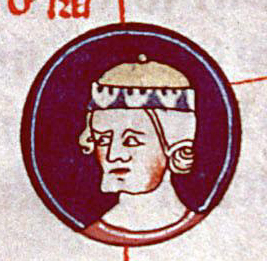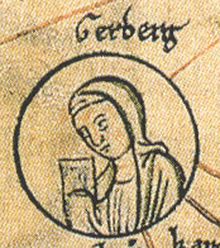
Hugh Capet was the King of the Franks from 987 to 996. He is the founder of and first king from the House of Capet. The son of the powerful duke Hugh the Great and his wife Hedwige of Saxony, he was elected as the successor of the last Carolingian king, Louis V. Hugh was descended from Charlemagne's son Pepin of Italy through his paternal grandmother, and was also a nephew of Otto the Great.

Hugh the Great was the duke of the Franks and count of Paris. He was the most powerful magnate in France. Son of King Robert I of France, Hugh was Margrave of Neustria. He played an active role in bringing King Louis IV of France back from England in 936. Seeking an alliance with the Holy Roman Emperor Otto the Great, he married Otto's younger sister Hedwig of Saxony in 937. They were the parents of Hugh Capet. Hedwig's sister, Gerberga of Saxony, was Louis' wife. Although he often fought with Louis, he supported the accession of Louis and Gerberga's son, Lothair of France.

Lotharingia was a medieval successor kingdom of the Carolingian Empire. It comprised present-day Lorraine (France), Luxembourg, Saarland (Germany), Netherlands, most of Belgium, and Germany west of the Rhine. It was named after King Lothair II, who received this territory as his share of the Kingdom of Middle Francia which his father, Lothair I, had held.

Hedwig of Saxony was a member of the Ottonian dynasty and wife of the Robertian duke Hugh the Great. Upon her husband's death in 956, she ruled the Robertian estates as a regent during the minority of their son Hugh Capet, the founder of the Elder House of Capet.
Henry I, called the Great, was Duke of Burgundy from 965 to his death and Count of Nevers through his first marriage. He is sometimes known as Odo-Henry or Otto-Henry, since his birth name was "Odo" and he only adopted "Henry" on being elected duke of Burgundy.
Otto-William was count of Mâcon, Nevers, and Burgundy.

Lothair, sometimes called Lothair II, III or IV, was the penultimate Carolingian king of West Francia, reigning from 10 September 954 until his death in 986.

Richard I, also known as Richard the Fearless, was the count of Rouen from 942 to 996. Dudo of Saint-Quentin, whom Richard commissioned to write the "De moribus et actis primorum Normanniae ducum", called him a dux. However, this use of the word may have been in the context of Richard's renowned leadership in war, and not as a reference to a title of nobility. Richard either introduced feudalism into Normandy or he greatly expanded it. By the end of his reign, the most important Norman landholders held their lands in feudal tenure.

Charles was the duke of Lower Lorraine from 977 until his death.
Liudolf, a member of the Ottonian dynasty, was duke of Swabia from 950 until 954. His rebellion in 953/54 led to a major crisis of the rising German kingdom.
Gilbert was son of Reginar and the brother-in-law of Emperor Otto I. He was duke of Lotharingia until 939. Gilbert was also lay abbot of Echternach, Stablo-Malmedy, St Servatius of Maastricht, and St Maximin of Trier.
Willa, known as Willa of Tuscany (911/912–970), was a medieval noblewoman. By birth, she was a member of the Bosonid noble dynasty. By marriage to Berengar II of Italy she was Countess of Ivrea from 930 to 963, and queen consort of Italy from 950 to 963.
Renaud or Ragenold, Count of Roucy was a 10th-century Viking who swore allegiance to the Frankish kings, and became the military chief of Reims after the restoration of the Archbishop Artald of Reims, upon taking the area back from Hugh of Vermandois.

Otto I, known as Otto the Great or Otto of Saxony, was East Frankish (German) king from 936 and Holy Roman Emperor from 962 until his death in 973. He was the eldest son of Henry the Fowler and Matilda of Ringelheim.
Gerberge of Lorraine was the daughter of Giselbert, Duke of Lorraine, and Gerberga of Saxony, daughter of Henry I the Fowler, King of Germany. She was a descendant of Charlemagne through both her parents. Gerberge died sometime after 7 September 978.

Matilda of France, a member of the Carolingian dynasty, was Queen of Burgundy from about 964 until her death, by her marriage with King Conrad I.
Gerberga of Burgundy was a member of the Elder House of Welf. She was married firstly to Herman I, count of Werl and secondly to Herman II, Duke of Swabia.

Ermentrude de Roucy (Irmtrude) was a Countess and Duchess of Burgundy.
Gerberga, Otto-William's mother, was, by her successive marriages, queen of Italy, margravine of Ivrea (965–970), and duchess of Burgundy (971/5–986/91).

Louis IV, called d'Outremer or Transmarinus, reigned as King of West Francia from 936 to 954. A member of the Carolingian dynasty, he was the only son of king Charles the Simple and his second wife Eadgifu of Wessex, daughter of King Edward the Elder of Wessex. His reign is mostly known thanks to the Annals of Flodoard and the later Historiae of Richerus.











